Bringing Kamigawa: Neon Dynasty Designs to Life
I like a good challenge. I'm eager to lead more challenging sets to design. I'm often then a culprit in further increasing the level of difficulty in execution on a set. Once it had been identified that we were returning to Kamigawa, I knew it was going to be a lot to pull off correctly.
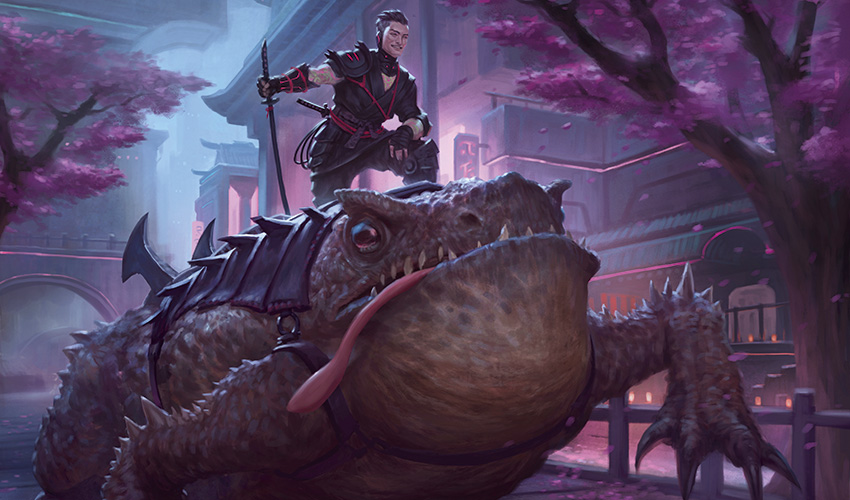
This time I was a bit nervous, though. While I was playing during the original visit to the plane, I knew I didn't have as strong familiarity with the plane or its real-world inspirations both old and new. This was going to be a time to rely heavily on the expertise of others to pull everything together. Fortunately, much like when I was leading Dominaria set design, wow, were there folks ready and eager to pour their love into this project. Mark Rosewater set me up well for success in leading vision design. The second part of his story on visions design in his next article will include introductions to my Set Design team members.
I'll highlight some of the key folks in shoring up my weaknesses. I've largely lost track of exactly which cycles and designs to attribute to whom, but I know that Ari Nieh and Daniel Holt had a huge hand in guiding me to cards that would excite fans of the plane from last visit and potential fans who'd be seeing it for the first time in its new form. On the day-to-day work, I can't thank them enough for bringing together the pieces for me to mold and giving me some idea on how to shape those components together. Emily Teng was a great partner in leading the worldbuilding side of things. I appreciate her work in answering questions for me without my being able to offer much help in return as she juggled the creative side of things to match changes on the mechanical side of the process.
As soon as I found out I'd be leading this set design, I reached out to our Duel Masters team. I asked if anyone from our Tokyo office might be able to help on the set. Soon enough, I found out that Koichiro Maki would be able to contribute working around his other responsibilities. Yuki Fujii graciously offered to help translate during design team meetings and other smaller meetings with Maki.
Each of them had great perspectives on what players in Japan would hope for out of this set, and what they felt was most and least appealing from our previous visit to the plane. They also both helped coordinate acquiring card designs and feedback from many other individuals in the Tokyo office. Maki created many documents with images he'd love to see, and of tropes and types of characters and objects he'd like to see created. These perspectives gave me so much more confidence that we'd be doing the correct things with the set. They had a heavy influence on which mechanics we entertained for set design.
With all this support, and as the concept art started rolling in and looking great, I began to believe we had something special here. Let's look through the mechanics. Mark Rosewater will delve more into why we didn't use some other past mechanics.
Artifacts and Enchantments
I loved the idea of there being a contrast between tradition and modernity as told via enchantments and artifacts. Having that spectrum be spread out on the colors of Magic was an awesome scaffolding from which to build the set. We've done enchantment sets. We've done artifacts sets. We've not explored what it means to be a set with each as a focus. I enjoyed the idea of color pairs that would focus on one or the other, or both. There would be a lot more nuance than a simple two-sided conflict.
The big challenge here was in trying to figure out the density of these elements, especially on creatures, and which creatures and at what costs to put these card types on by the time art concepting began.
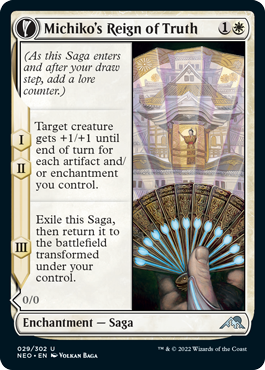
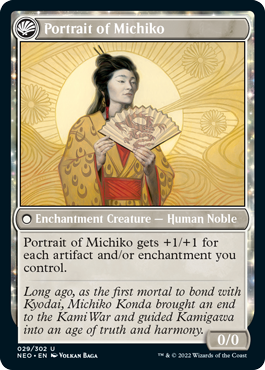
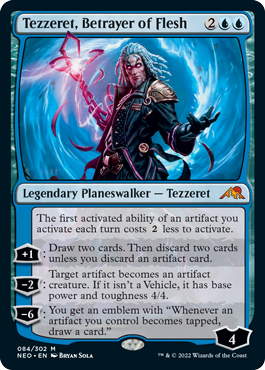
Modifications
Much of the vision design work included creating "enhanced," later to be named "modified," that looked for creatures that had Auras or Equipment attached or had counters on them. This largely went through unchanged, other than deciding that your opponent's Auras would not count toward turning on your modified rewards.
The main directional change we took with this mechanic was moving it more into a tribal space to reward the number of modified creatures, so it wasn't all about self-contained rewards or checking to see if you had a single modified creature. I wanted there to be enough rewards in spreading out mods such that games wouldn't be about going all in on one creature.
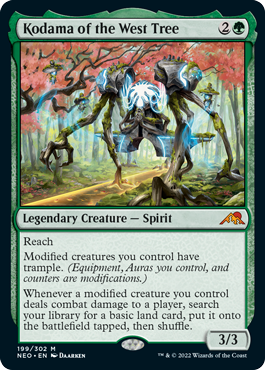
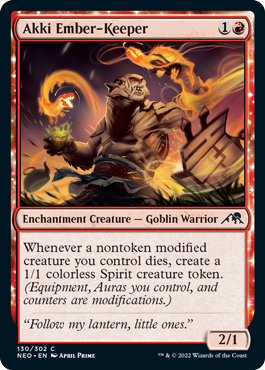
Ninjutsu
Ninjutsu wasn't in the handoff from vision design. A lot of that stemmed from the focus on modifications that I just described. If mods were a big part of the set, they'd just "fall off" if you returned your creature to hand via Ninjutsu. The more I talked to folks about what they most wanted to see here, the more I could tell that we should really have this mechanic or something like it.
For much of set design, we tested a variant that would let you keep your mods on the Ninja that had just appeared. Ultimately, though, this proved more difficult to explain and led to swingier gameplay than we wanted. The Ninja decks were often more focused on getting creatures through than building up creatures anyway, and the focus of these themes didn't have a lot of overlap in colors. In the end, we decided to return to the original mechanic.
We also made some other tribal cards that cared about Ninjas and Rogues. Vision design had broadened this grouping to make sure there was more backwards compatibility to other sets.
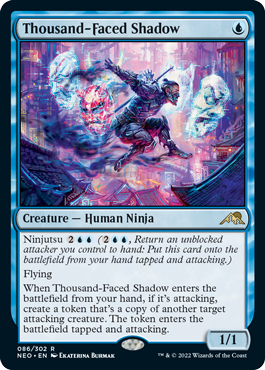
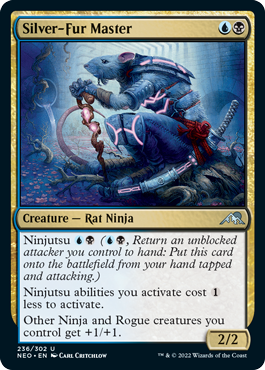
Channel
Channel is super versatile. Maybe too versatile. The mechanic felt like low-hanging fruit to use as a returning mechanic. The set was otherwise lacking a smoothing mechanic, by which I mean a mechanic that alleviates less-than-ideal mana draws. I was eager to use cards with channel as a tool to provide players with options where they otherwise might not have any. While I wanted to show a diversity of effects, I also wasn't shy about making cards that resembled other mechanics like cycling. We decided to limit channel to cards that are artifacts, enchantments, or lands.
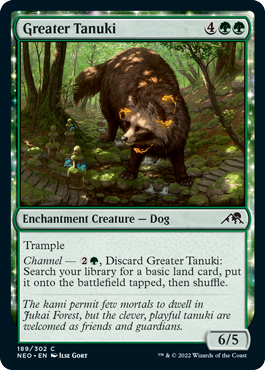
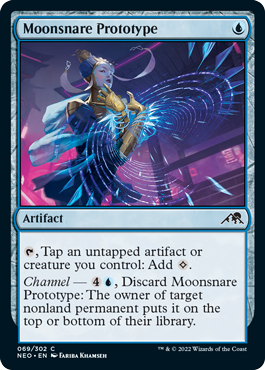
Legends
Legendary was a big theme of original Kamigawa. I wanted to capture that with a lighter touch since it's more recently become part of the identity of Dominaria. While I'm normally not a big fan of legendary lands, channel was a good mechanic to justify giving them a shot. We put on the cost reduction for legendary creatures as a nod to legendary themes and to help differentiate them from modal double-faced card (MDFC) lands in Zendikar Rising.
We felt one of the easier ways to hit on legends was simply to provide more to the fans of Kamigawa for Commander. Only one of the 102 commanders in the original Kamigawa block was multicolor. That left a lot of fertile ground to explore.
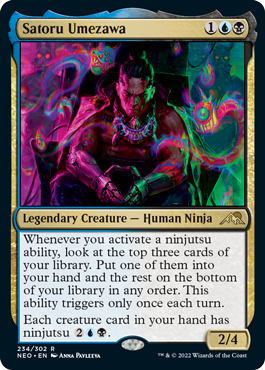
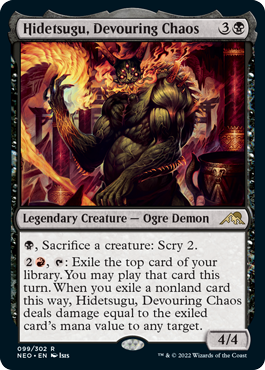
Cycles
Beyond the legendary lands, there were many cool cycles that various designers helped pull together with creative or mechanical ideas.
The Dragons from original Kamigawa were iconic. The modal death trigger seemed solid from start to finish.
Shrines are also a beloved grouping of cards. We thought we'd try them out as creatures this time for new avenues of play and counterplay.
There's a cycle of cards playing in the space of the Shoals that required quite a bit of iteration by my team and play designers. Keep an eye out for them.
We also have a splashy cycle of "Invoke
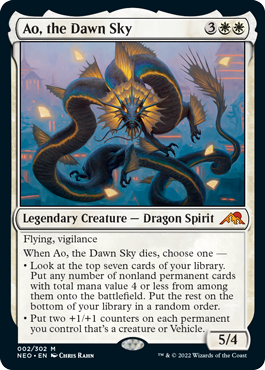
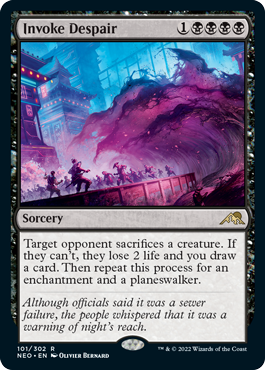
Sagas
Sagas are so wonderful. As game objects, they do so much creatively. I was excited by the idea of stories coming to life as creatures. The biggest development challenge on these was that for most of design we played with these simply transforming rather than exiling and returning transformed. Jadine Klomparens had the wisdom to see that we needed to make that particular change for better gameplay.
These cards were playing too aggressively and not allowing for enough counterplay. We could then give back strength to other parts of the card that were more fun. We did like how some of the cards played with haste and added that back, along with the change to a handful of others. The other main decision we made was to not put "Legendary" on the reverse side of stories depicting legends.
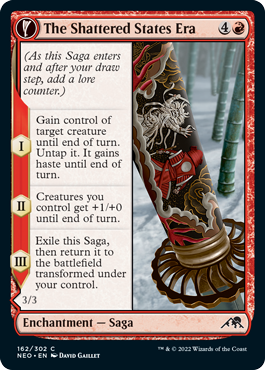
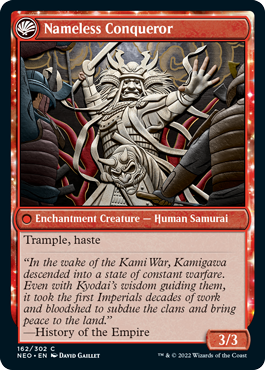
Reconfigure
I was enamored with the suggestion that the new modernity mechanic be creatures that could take the form of Equipment. Conceptually, it sounded cool to me. I felt that it would also alleviate some of the pain points in Equipment gameplay. You wouldn't be punished for drawing too many Equipment cards and not enough creatures. And your opponent would have more natural points of interaction with your Equipment since they'd often be more vulnerable in creature form.
We decided that the gameplay was fine on these to use in an attack, take them off, and have them back as a blocker. We also felt that some could grant their stats but that we didn't need to do that in all cases.
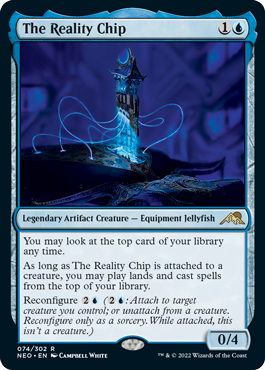
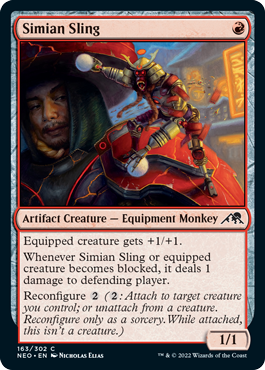
Samurai (and Warrior)
It was a bit trickier dealing with Samurai. Bushido is a fine, simple mechanic, but I find it a bit lacking. You often don't have that much agency over the mechanic. Your opponent might have too much evasion to block, they might not need to block, or they might not even be playing creatures. I was interested in a more proactive text leading to more reliable rewards.
Here, again, we wanted to batch together Samurai with Warriors. I'd been interested in trying a variant of exalted for quite some time, where there'd be variable rewards instead of +1/+1 until end of turn. We began trying out "Whenever a Samurai or Warrior you control attacks alone, (effect)." It felt like a reasonable match creatively, and many players gravitated to the decisions it created in games.
While at least one Samurai was putting itself at risk each attack, our main challenge here was avoiding any given effect feeling too oppressive if it started to repeat itself. All said, I'm happy with it as a combat-centric mechanic that rewards some novel play.
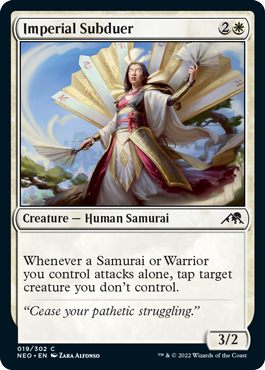
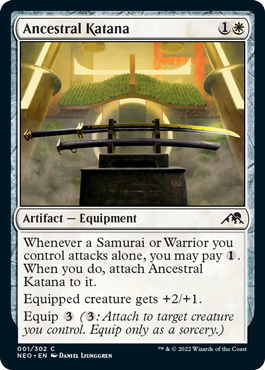
A Touch of Phyrexia
I enjoyed the challenge of sticking to the mechanical structure of Jin-Gitaxias in following in the footsteps of the Vorinclex I helped create while leading set design for Kaldheim.
It was fun to dial up the Phyrexian influence here, including working on the design for something as special as Tamiyo.
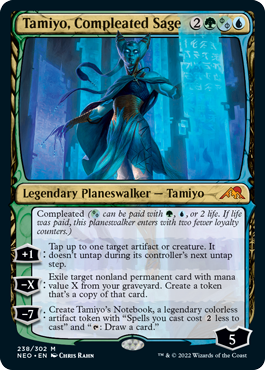
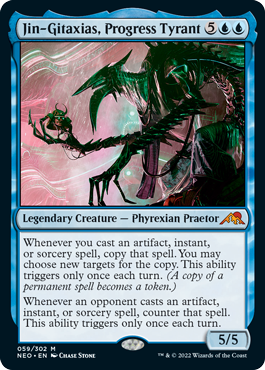
Tatsunari, Toad Rider
My preview card today had its beginnings in an email of designs from Maki. He mentions that one of his colleagues, Masahiro Kamada, gave him many ideas for the document. The third concept on his list was two designs for a Ninja riding a big toad with an example image attached. Each of the designs created a legendary frog token. One of the designs let you discard Sagas to help you protect the toad.
My understanding is that these were a take on Jiraiya, a character in old Japanese folk tales who has also been adapted into popular modern interpretations. This seemed like a great starting point to polish into something charming.
We ended up broadening out caring about Sagas to all enchantments and adding an ability to convey them hopping along together. Tatsunari was a favorite among some play designers in green-black enchantment decks.
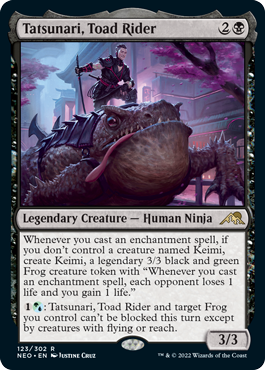
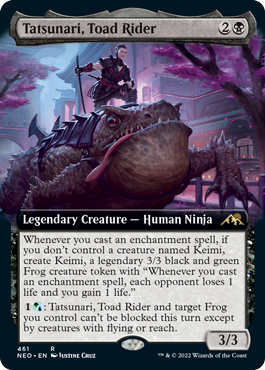
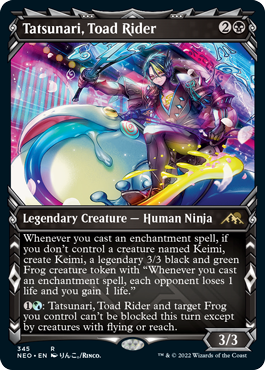
Thanks for reading. This set is packed. I didn't even talk about the cool Vehicles. I hope you enjoy all the set has to offer!
—Dave Humpherys

